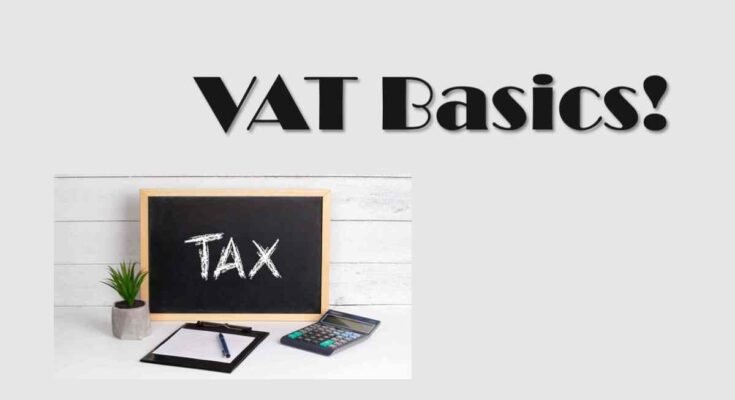Value Added Tax (VAT) is a consumption tax that is levied on goods and services at every stage of production or distribution. It applies to the value added at each point in the supply chain, from raw materials to the final sale to consumers.
This tax system apply in over 160 countries, including the European Union, the UK, Canada, and many others. So, to understand the basic of VAT, how VAT works and what impact it has on businesses and consumers is essential in the global economy.
This article provides a detailed overview of VAT, explaining its purpose, how it operates, and its importance.
What is VAT?
VAT is a tax that businesses have to pay to their respective governments based on the value added to a product or service during the production process.
This value is the difference between the selling price of the product and the cost of the goods or services used to make it.
Unlike sales tax, which is only levied at the point of sale to the final consumer, VAT is levied at each stage of the supply chain.
For example, if a manufacturer sells a product to a retailer, VAT is levied on that transaction. When the retailer sells the product to the consumer, VAT is levied again.
Ultimately the consumer bears the burden of the tax because businesses can usually recover the VAT paid on their inputs through a system called input tax credits.
Purpose of VAT
VAT serves a number of purposes, both economic and fiscal. From the government’s perspective, VAT is an important source of revenue.
Since it is collected at stages in the supply chain, it generates more stable and predictable tax income than other forms of taxation, such as corporate income tax or personal income tax.
Additionally, since VAT applies to a wide range of goods and services, it ensures a broader tax base and reduces tax evasion compared to systems that rely heavily on income taxes.
From an economic perspective, VAT is considered more efficient than a sales tax because it does not create distortions between businesses that produce goods domestically and businesses that import them.
VAT can also promote efficiency because businesses can reclaim the VAT they paid on their purchases.
How VAT Works?
To understand how VAT works, let’s understand the process step-by-step:
- Manufacturer: The first party in the supply chain is usually the manufacturer. They purchase raw materials and pay VAT to the supplier on these materials. When the manufacturer sells the finished product to a wholesaler or retailer, they charge VAT on the total price of the product. The VAT collected from the sale is paid to the government. However, the manufacturer can deduct the VAT paid on the raw materials (input VAT) from the VAT collected on the sale (output VAT).
- Wholesaler/Retailer: When the retailer purchases the product from the manufacturer, they pay VAT on the purchase. The retailer can then sell the product to the final consumer, charging VAT on the sale price. The VAT collected is paid to the government, but the retailer can deduct the VAT paid to the manufacturer.
- Final Consumer: At the end of the chain, the final consumer buys the product and pays the VAT, but they cannot get it back. This means the consumer bears the full tax burden of the VAT.
VAT Rates and Exemptions
VAT rates vary from country to country, and sometimes even within countries. Most countries have a standard VAT rate, but many countries also apply reduced rates to specific goods and services.
For example, essential items such as food, medicine, and educational materials may be subject to lower VAT rates or be exempt from VAT altogether.
In the European Union, VAT rates range between 17% and 27%. For example, in the UK, VAT rates range between 17% and 27%.
However, the standard rate of VAT in the UK is 20%, while a reduced rate of 5% applies to specific items such as household energy and children’s car seats. Zero-rated goods such as most food and books do not incur VAT.
VAT exemptions are also common, in certain sectors such as health, education and financial services may be VAT-exempt.
Businesses in these sectors cannot charge VAT on their sales and cannot reclaim VAT paid on their inputs, which can increase operating costs.
VAT Registration for Businesses
Businesses that meet specific sales thresholds are generally required to register for VAT. Once registered, they must charge VAT on all applicable sales, file regular VAT returns and pay the collected tax to the government.
Registration thresholds vary by country. For example, in the U.K. In the US, businesses with a taxable turnover of more than £85,000 must register for VAT.
Many countries also provide a reverse charge mechanism for cross-border trade within VAT-registered businesses.
This allows the recipient of goods or services to pay VAT rather than the supplier, simplifying international transactions.
Benefits and Challenges of VAT
Benefits:
- Stable revenue source: VAT provides a consistent and reliable revenue stream for governments, which helps fund public services.
- Reduced tax evasion: Because VAT is collected at different stages of production, it reduces opportunities for tax evasion.
- Encourages efficiency: VAT encourages businesses to maintain proper records and claim input VAT credits, thereby improving economic efficiency.
Challenges:
- Regressive nature: VAT is considered regressive because it affects low-income individuals more, as they spend a greater portion of their income on taxable goods.
- Complexity for businesses: Compliance with VAT regulations can be complex, especially for small businesses that may struggle to file returns and manage VAT recovery.
Conclusion
VAT is an important part of the global tax system, and provides a stable revenue source for governments. Therefore, it is important for both businesses and consumers to understand how VAT works, what the applicable rates are and what exemptions are available. VAT has many benefits, such as reducing tax evasion and promoting efficiency, but it also has challenges, particularly its regressive nature and its complexity for businesses.


